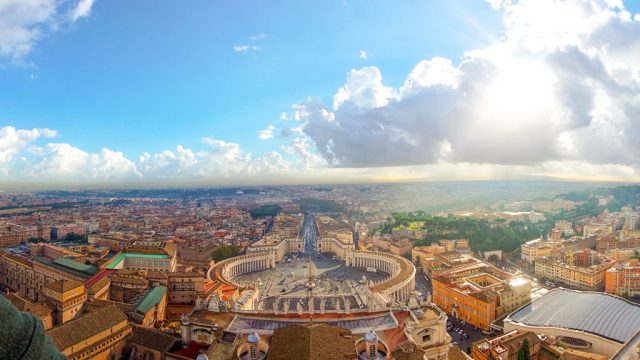Why Are There Walls Around the Vatican?

“In this new world we live in, we can’t isolate ourselves,” Obama declared to a crowd of 70,000 in Berlin today. “We can’t hide behind a wall.”
He was probably talking about the Berlin wall—he was standing, after all, just a few feet from the once menacing concrete barrier that divided the city—but it was probably also a not-so-subtle jab at his presidential successor, the guy with the ostentatious handshake who keeps insisting he wants to build a “big, beautiful wall” on the U.S. and Mexico border.
It’s also likely not a coincidence that Obama’s comments came during Trump’s first visit to the Vatican, to meet the man who once mocked his wall ambitions. “A person who thinks only about building walls, wherever they may be, and not building bridges, is not Christian,” Pope Francis remarked last year. Trump responded by calling Francis “disgraceful,” and his campaign’s social media director tweeted “Amazing comments from the Pope—considering Vatican City is 100% surrounded by massive walls.”
With all the political talk about walls again, and where they should and shouldn’t exist, it made us wonder: why is there a wall around the Vatican, anyway? Who exactly are they trying to keep out? Or maybe keep in? Read on to learn the answer.
“A Little Extra Protection”
The answer is exactly what you were expecting. The Vatican walls were built to keep out pirates. (Wait that wasn’t what you were expecting? Weird.)
During the 9th century, Saracen pirates were pillaging much of southern Italy. When they sacked St. Peter’s in 846, Pope Leo IV decided he needed a little extra protection. A 39-foot-tall wall was constructed around Leonine City, an area which included the current Vatican territory.
“Gradually the Muslim threat receded and many gates were opened in the walls,” says Thomas Noble, a papal history expert at Notre Dame University. But then came the 16th century and a new pope, Pius IV, who proclaimed, “Nah! Close ‘em up, boys.” (We’re paraphrasing.) “The problem in those later times was that political violence in Rome sometimes threatened the papacy,” says Noble. It wasn’t pirates this time, but Roman Emperors looking to pick a fight (and maybe steal some of the church’s sweet art.)
“A Sign of Papal Power”
The Vatican walls stayed even when the threats disappeared because a wall isn’t always about keeping out bad guys. Ancient walls look cool. “Remember that the great Renaissance Popes sought to restore Rome and the Vatican Area to be the glory of the civilized world,” says Diane Apostolos-Cappadona, a Catholic studies professor at Georgetown. St. Peter’s Basilica Church was built to be “the largest church in Christendom and the center of pilgrimage in Europe,” she says. Surrounding it all with a wall was a “sign of papal power.”
But it’s a symbolic power more than an oppressive “keep out” power. “Building walls, whether in China or the north of Britain or anywhere else, have always been political statements,” says Noble. “They have never served as effective barriers.”
The Vatican walls are anything but effective. It’s more difficult to get through airport security at JFK than to get into Vatican City. Once you’re through the metal detectors, well, that’s it. As for identification, it doesn’t take much. Ken Pennington, a professor of medieval history at Washington’s Catholic University of America, frequently visits Vatican City, and he says the only I.D. he’s ever needed is his Vatican library card. “It’s true,” he laughs. “Have library card; will travel.”
How to Get Stuck in the Vatican
Obama may have been right that we can’t “hide behind a wall.” But there’s no danger of that happening at the Vatican. The only way of hiding in there is if the person trying to find you doesn’t know where the entrance is, and has a lot of metal plates in their body, and doesn’t have a library card.
To discover more amazing secrets about living your best life, click here to follow us on Instagram!